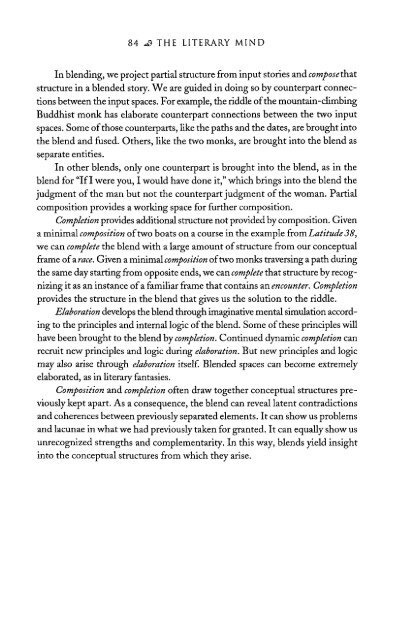The Literary Mind.pdf
The Literary Mind.pdf
The Literary Mind.pdf
Create successful ePaper yourself
Turn your PDF publications into a flip-book with our unique Google optimized e-Paper software.
84 THE LITERARY MIND<br />
In blending, we project partial structure from input stories and compose that<br />
structure in a blended story. We are guided in doing so by counterpart connections<br />
between the input spaces. For example, the riddle of the mountain-climbing<br />
Buddhist monk has elaborate counterpart connections between the two input<br />
spaces. Some of those counterparts, like the paths and the dates, are brought into<br />
the blend and fused. Others, like the two monks, are brought into the blend as<br />
separate entities.<br />
In other blends, only one counterpart is brought into the blend, as in the<br />
blend for "If I were you, I would have done it," which brings into the blend the<br />
judgment of the man but not the counterpart judgment of the woman. Partial<br />
composition provides a working space for further composition.<br />
Completion provides additional structure not provided by composition. Given<br />
a minimal composition of two boats on a course in the example from. Latitude 38,<br />
we can complete the blend with a large amount of structure from our conceptual<br />
frame of a race. Given a minimal composition of two monks traversing a path during<br />
the same day starting from opposite ends, we can complete that structure by recognizing<br />
it as an instance of a familiar frame that contains an encounter. Completion<br />
provides the structure in the blend that gives us the solution to the riddle.<br />
Elaboration develops the blend through imaginative mental simulation according<br />
to the principles and internal logic of the blend. Some of these principles will<br />
have been brought to the blend by completion. Continued dynamic completion can<br />
recruit new principles and logic during elaboration. But new principles and logic<br />
may also arise through elaboration itself. Blended spaces can become extremely<br />
elaborated, as in literary fantasies.<br />
Composition and completion often draw together conceptual structures previously<br />
kept apart. As a consequence, the blend can reveal latent contradictions<br />
and coherences between previously separated elements. It can show us problems<br />
and lacunae in what we had previously taken for granted. It can equally show us<br />
unrecognized strengths and complementarity. In this way, blends yield insight<br />
into the conceptual structures from which they arise.















